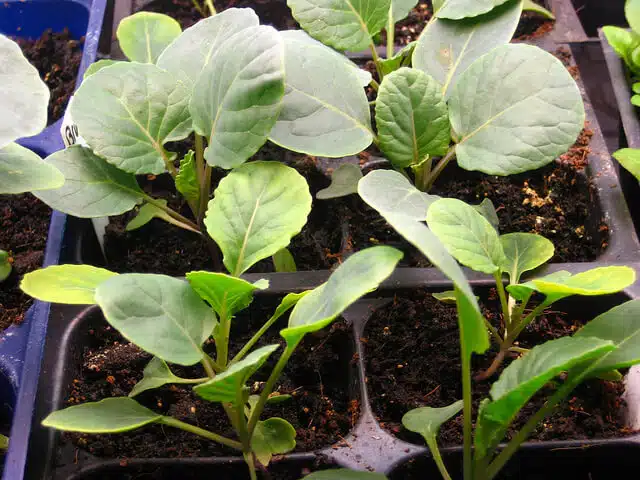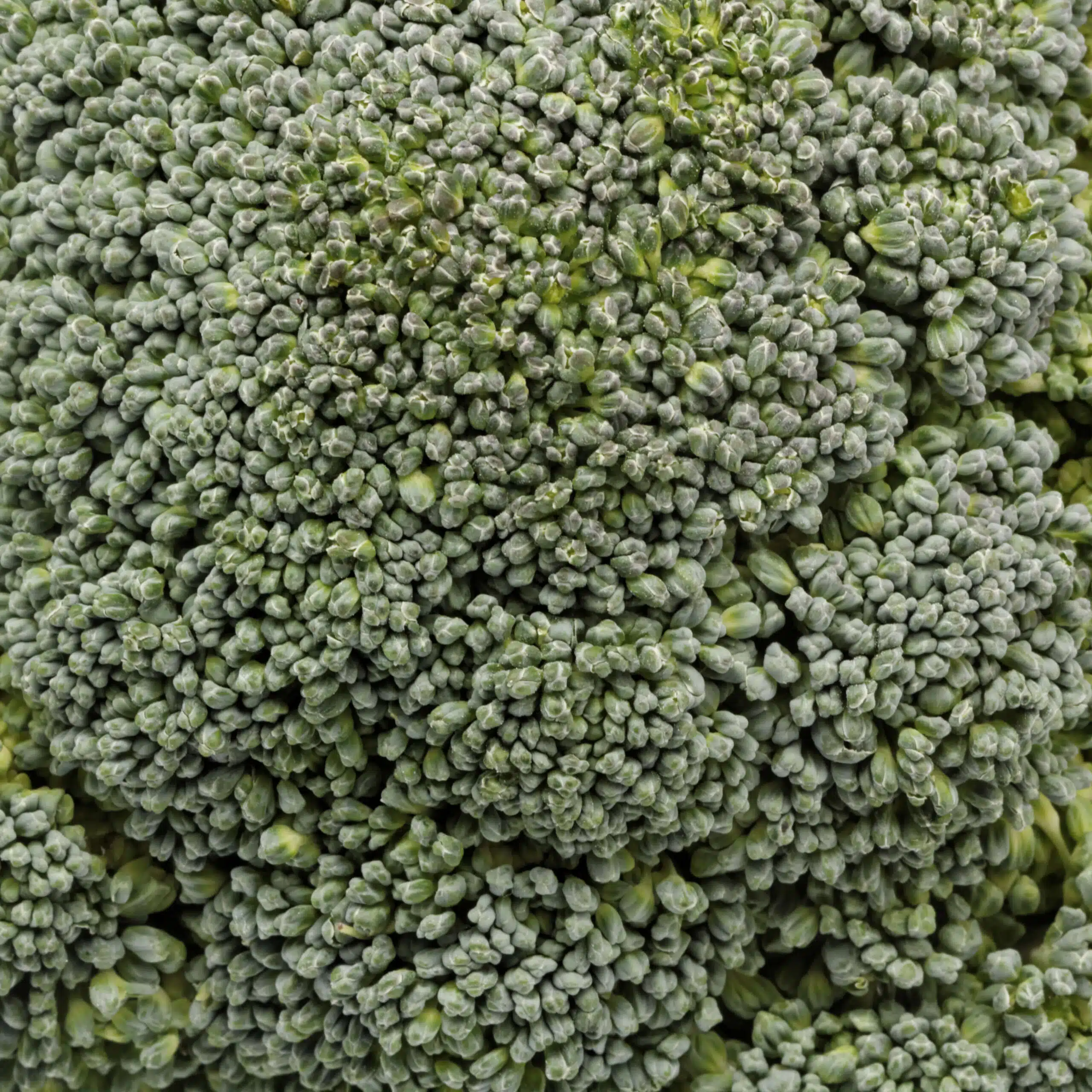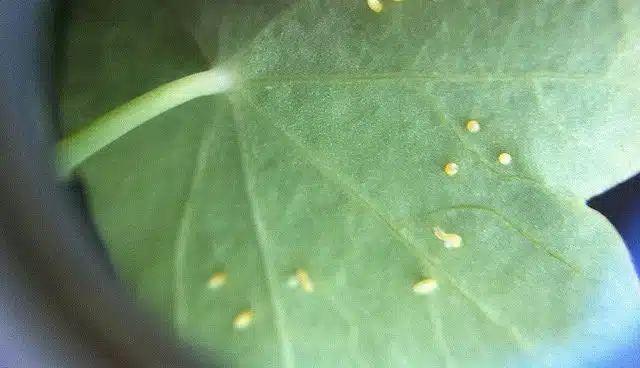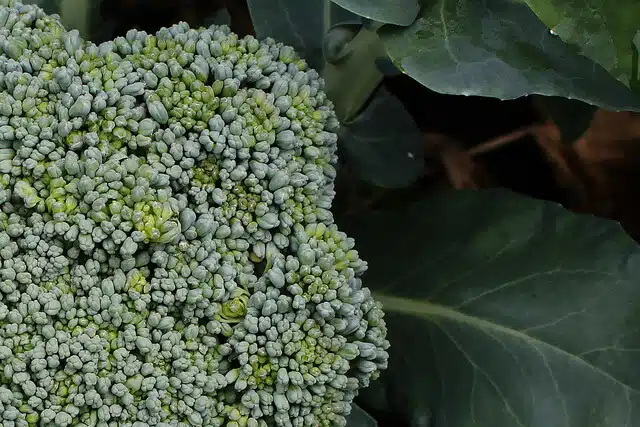Broccoli might seem an unusual choice for containers. It’s a comparatively large veggie and has a big appetite.
But I hope you’re reading this article because you haven’t been deterred from giving it a go. Growing broccoli in pots is a very rewarding experience.
A big plus is that you’ll be able to harvest the nutritionally dense parts of the plants, namely the leaves, stem and smaller florets, that usually get discarded.
You might also be surprised to learn there are a number of unusual types of broccoli, including purple, white and perennial varieties. The perennial variety is a great choice for container growers and I’ve dedicated a paragraph to it below.
Quick Navigation: Factsheet | Sowing/Harvesting Calendar | Potting Soil | Sowing & Planting |Growing Tips | Harvesting | Storage & Eating | Pests & Problems | Varieties for Pots | More Resources
Factsheet
| Sprouting time: | 1 to 2 Weeks |
| Time from sowing to harvest: | 3 Months (For Most “Calabrese” Varieties) 9 Months (When Overwintering) |
| Size of pot: | Large |
| Difficulty of growing in pots? | Medium |
Sowing and harvesting calendar
Sow: April to early June
Harvest: August to October or February to April if overwintered
Potting soil tips
- Broccoli prefers a rich, somewhat firm but also well-draining potting soil. It will do well in a mix that’s reasonably loose, but not overly so. It will get very upset if you don’t provide adequate nutrition.
- Go for a peat or coir-based potting mix that doesn’t include an excessive amount of drainage material. If you’re putting together your own mix, I’d recommend 35% peat or coir, 35% organic matter (like compost or well-composted manure) and 30% drainage material like grit or perlite.
Sowing and planting
- There are two ways to sow broccoli, and you should adapt your approach depending on your climate. Green (Calabrese) varieties tend to be sown early in the year and harvested in autumn. Purple and white varieties are usually planted in early summer and overwintered, for a harvest in spring the following year.
- If you live in a hot climate, opt for the latter, as the chances of your plants running to seed are likelier. If you live in a mild climate, you can choose either, but a same-year harvest is likely to be preferable. There is, of course, some overlap between varieties, so always check the specific growing advice.
- Broccoli prefers lower temperatures, so with early varieties, it’s best to get started as soon as possible in the year. I would recommend sowing in peat pots in February, on a windowsill or in a greenhouse propagator.
- Alternatively, if you intend to sow during summer, your plants will be ready to harvest early the next year. This is generally the best option for warm climates.
- Sowing directly into pots outdoors increases the likelihood that seedlings will be eaten. Don’t move young plants outside until they’re at least three inches tall. It’s better to pick the strongest growers and put one to a pot (in the middle) rather than plant many and thin out later.

- Finally, use the biggest pot possible! Anything under 16 inches or so in height is an absolute no-no. Ideally, you’ll go for something double that size!
Growing tips
- There are two absolutely necessary jobs when growing broccoli: feeding and watering.
- I don’t recommend relying on slow-release granules. Once the plant gets established (a month or so after planting out), liquid feeding with both a balanced NPK feed and a micronutrient feed is the best strategy. If you absolutely have to use slow-release granular fertilizer, mix it in liberally when preparing your potting mix.
- Water generously on hot dry days. Using a peat or coir-based potting mix will ensure good moisture retention.
- Broccoli needs full sun to grow well, so reserve your best spot. Because it’s “greedy”, broccoli isn’t one of those plants that will do “okay” if it’s left in shade for a large portion of the day. If your growing space doesn’t receive direct sunlight, opt for something else.
- Birds may be an issue, with pigeons a prime culprit for nibbled leaves in the city. Covering with some netting will keep your precious plants safe from these feathered pests.
- If you’ve decided to overwinter your plants, stake them to prevent the wind from blowing them over. If stems become loose, firm up the potting mix around the base of the plant.
Harvesting
- A broccoli head is a tightly-packed cluster of closed flower buds (florets). It’s time to harvest when the head is well-formed – as you would expect to find it in a supermarket – but before the florets have a chance to open.

- You can treat broccoli as a come-and-cut-again crop. After you have harvested the main head, smaller sprouts will start to appear until winter starts to set in. Don’t snip off all of the side-shoots at once. Let them grow to “maturity” (i.e. form fully) before harvesting. As with the main head, don’t let them flower!
- You can also parsimoniously harvest leaves. Never take more than a third and allow the plant to replenish itself before picking again.
Storage & Eating
- Straight out of the ground (or off the stem), fresh broccoli doesn’t have a long shelf-life and will need to be eaten within a few days.
- If you want to freeze your broccoli heads, parboil in salted water for a few minutes before putting them in the freezer.
- Please, please, please don’t throw away the stem. It’s tasty and jam-packed with nutrients.
Pests and problems
Broccoli can be prone to pests. Growing in pots will usually overcome the issue of soil-borne pests. City environments also tend to be unwelcoming for insects. That said, brassicas are a favourite of uninvited dinner-guests and you should watch out for the following:
- Cabbage worms/caterpillars – There are a number of caterpillars that love the scrumptious taste of brassicas. Holes in leaves are the obvious sign. Prevention is a matter of checking the undersides of leaves and removing any eggs, which are usually white or yellow. If you find any caterpillars, pick them off. You can buy nematode-based insecticides (nematodes are microscopic threadworms that will get inside the caterpillars and kill them).

- Mealy cabbage aphids – Blackish/grey aphids that look as though they’re covered with a white powder can amass on the undersides of leaves. They’re of particular concern in the early stages of a plant’s life. Pull off affected leaves.
- (Cabbage) Whitefly – These white, winged insects feed on the phloem (living tissue) of the leaves and cause mould on feeding sites. Little colonies occupy the undersides of leaves. They’ll rarely cause significant damage and can be tolerated. Scrape off colonies if you see them.
- Pigeons – Pigeons can be annoying pests, especially if you’re growing in the city. The droppings also have to be thoroughly removed when cooking. A good bird scarer will often keep the birds away. Netting is a foolproof counter-measure if you can be bothered to set it up.
Good broccoli varieties for pots
Good varieties for US growers include:
- Nine Star Perennial – As long as you don’t let the florets open, you’ll get yields year after year. It looks a bit like a mix between cauliflower and broccoli (remember that broccoli and cauliflower are both descendants of wild cabbage).
- Sun King Hybrid – A compact variety which will only grow to 35cm (14 in.) in height. Plants have pleasing blue-purple heads. Two and a half months to harvest.
- Waltham 29 – A larger variety (though not as big as some) that will grow to around 65cm (25in.) in a pot. It’s very resistant to the cold, so is a good candidate for overwintering. It produces lots of side-shoots.
Good varieties for UK growers include:
- Nine Star Perennial – See above.
- Belstar – A compact F1 hybrid that, with a spread and height of no more than 45cm (17 in.), is ideal for container growers.
- Ironman – Another relatively compact variety that’s quick-cropping and has good resistance to bolting.
- Romanesco – This odd looking plant, called Romanesco Broccoli, is worth considering. It’s compact, with a spread of around 40cm (16 in.) and tastes midway between cauliflower and broccoli.
More Resources
- I’m a big fan of steamed broccoli with garlic and rice (I ate it a lot in Asia). It’s a simple but very nutritious and tasty dish. Here’s a recipe to check out.
- A wonderful article on Nine Star Perennial Broccoli by Alys Fowler (all her articles are wonderful).
What are your thoughts? Leave a comment below!
Have you tried growing broccoli in containers? Leave a comment below and let me know how it went!
Image credits: Gail Langellotto, mcav0y, woodleywonderworks, Coyau.
